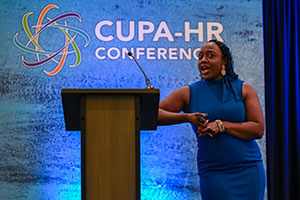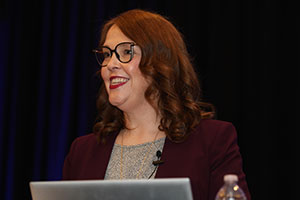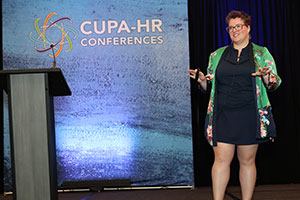by Julie Burrell | June 4, 2025
At the recent CUPA-HR Spring Conference in Seattle, artificial intelligence was a major topic of conversation, from session rooms to hallway discussions. AI has reshaped how many HR pros operate. It’s now being used as a daily tool, whether as a personal assistant for daily tasks or a strategic thought partner in decision-making.
Here’s how higher ed HR is using AI now.
Drafting communications and messaging. AI can help draft everything from emails to campus-wide communications. At her spring keynote, Jennifer Parker of the Colorado Community College System said she uses ChatGPT to rewrite her emails to be more formal in tone. She also recommends trying out AI to make internal communications more creative and tailored, like an inspiring message inviting specific groups of employees to review their benefits during open enrollment.
Making meetings more productive and presentations easier. AI is helping HR pros compile, organize and summarize their meeting notes. AI can also make checklists and to-do’s following meetings. Use AI to create slide decks and scripts for presentations.
If you’re looking to maximize your time, quickly make your longer meeting notes — like those from the recent CUPA-HR conference — into a conversational podcast using Google’s NotebookLM tool.
Helping you with internal talent development or coaching for individual career paths. AI can help you create a training or professional development program in record time, like Jennifer Parker did with her civility training program. It can also act as a career coach when used with the right prompts.
Assisting in talent acquisition. With AI, writing job descriptions has never been easier. For interviews, enter in a job description and ask AI to come up with applicable interview questions or ask for help in creating interview questions that are more neuroinclusive.
Injecting some creativity throughout the day. Members also shared imaginative uses of AI, like using Doodly to create animated whiteboards, asking ChatGPT to turn selfies into Lego minifigures, or using Canva’s AI features to make eye-catching designs.
Scaling Up
AI can do amazing things when used on a larger scale. HR pros are tackling more extensive projects with AI, often in collaboration with other departments.
Analyzing feedback and surveys. AI can process the results of open-ended survey questions and help identify themes to make surveys more effective than ever, with the partnership of survey experts and AI practitioners on campus.
See how Harvard University’s Center for Workplace Development used AI in combination with HRIS data to create a strategic needs assessment survey.
Brainstorming and researching for deeper insights. Proprietary software like Microsoft Copilot enables a deeper dive into existing institutional information and data. By uploading your institution’s mission and strategic priorities, you can accomplish any number of initiatives. Try creating recruitment materials, professional development programs, performance metrics and evaluations, or even a strategic priorities document specific to HR.
During their presentation, the talent management team at Grand Valley State University shared how they integrated AI into their process for creating core competencies. AI assisted them in brainstorming key competencies, cross-checking those competencies with their institutional values, and transforming them into action-oriented language.
Training Others on AI. Many HR leaders have been encouraging their employees to experiment with AI, including launching trainings or directing staff to existing trainings. For example, Microsoft offers general Copilot trainings and HR-specific trainings, all self-directed.
While AI adoption is picking up speed, there are certainly challenges in incorporating it into your workflow. Spring conference attendees mentioned concerns ranging from legal compliance to ensuring truth and authenticity in communication. But used with safeguards, AI has the potential to free up time and allow HR to do what it does best: the fundamentally human work of caring for the people on your campus.




 Because our brains interpret emotional threats in the same way as physical threats, feeling unsafe at work can provoke a similar feeling to walking alone in a dark parking garage or seeing a snake on a hiking trail. But when we feel a sense of psychological safety and social belonging, our brains shift into connected mode. When we feel safe, we’re more likely to collaborate with our team, be less resistant to change and feel creative.
Because our brains interpret emotional threats in the same way as physical threats, feeling unsafe at work can provoke a similar feeling to walking alone in a dark parking garage or seeing a snake on a hiking trail. But when we feel a sense of psychological safety and social belonging, our brains shift into connected mode. When we feel safe, we’re more likely to collaborate with our team, be less resistant to change and feel creative.








